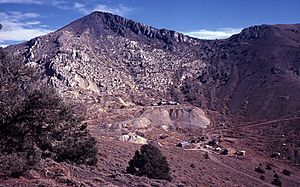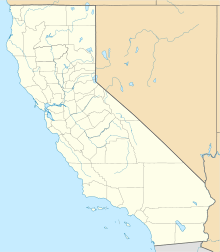Cerro Gordo Mines facts for kids

Cerro Gordo Mines and ghost town in 1980
|
|
| Location | |
|---|---|
| Location | near Keeler, California |
| State | California |
| Country | United States |
| Coordinates | 36°32′16″N 117°47′42″W / 36.53778°N 117.79500°W |
| Production | |
| Products | silver, lead, and zinc |
| Type | underground |
| Greatest depth | at least 1,100 ft (340 m) |
| History | |
| Opened | 1866 |
| Closed | 1957 |
| Owner | |
| Company | Brent Underwood |
The Cerro Gordo Mines are a group of old, unused mines. They are found in Cerro Gordo in the Inyo Mountains, Inyo County, California. This area is close to Lone Pine, California. Mining here happened from 1866 to 1957.
Workers dug up valuable metals like silver, lead, and zinc. Sometimes, they also found gold and copper. Some of the metal was melted right there. But bigger melting factories were built near Owens Lake.
These melting factories helped start the towns of Swansea and Keeler. Most of the metal bars were sent to Los Angeles. But moving the metals was very hard. This made it tough for the mines to be successful. Mining for silver and lead was biggest in the early 1880s. A second mining boom for zinc happened in the 1910s.
At its busiest time, about 4,700 people lived in Cerro Gordo. Today, it is known as a California ghost town.
Contents
History of Cerro Gordo Mines
How Mining Started
A man named Pablo Flores is said to have found the silver ore in 1865. He began mining and melting operations. More people started moving to the area. But the Native Americans living there did not want them. This made early mining difficult.
Later, Fort Independence was built. This allowed more miners to come in. The mining town then grew much larger.
Early Mining Methods
At first, miners used simple ways to dig. They made open pits and trenches. They also used ovens made of adobe to melt the ore. A businessman named Victor Beaudry saw the good quality silver. He opened a store nearby.
Soon, he took over several mining claims when people could not pay their debts. He then built two modern melting factories. Beaudry kept getting more mining rights. He soon owned most of the best mines. This included part of the Union Mine.
Mortimer Belshaw and the Yellow Road
In 1868, Mortimer Belshaw came to Cerro Gordo. The name "Cerro Gordo" means "Fat Hill" in Spanish. He was interested in the rich deposits of galena ore. Belshaw teamed up with another owner of the Union Mine. He then took the first wagon load of silver from Cerro Gordo to Los Angeles.
In Los Angeles, he got money to build his own melting factory. It was better than all the others in Cerro Gordo. He also built the first wagon road up the mountain. This road was called the Yellow Road. It got its name from the color of the rock it was cut through. Belshaw charged a fee to use the Yellow Road. This helped him earn money and control the silver shipments.
Mining Production and Zinc Boom
Between 1879 and 1880, the Cerro Gordo area produced a lot of ore. It made $3,307 worth of gold and $140,517 worth of silver. Over its whole history, from 1865 to 1949, the mines produced huge amounts of lead, silver, and zinc. This was worth more than $17 million!
By 1907, a lot of high-quality zinc ore was found. Shipping of zinc ore began. By 1912, Cerro Gordo became the biggest producer of zinc carbonates in the U.S.
In 1916, the town got electricity. This replaced the steam power used for the machines. By 1938, most mining had stopped. As of 2019, only one former teacher was still mining small amounts of silver. He sold it to tourists.
The Cerro Gordo mines were very large. They had more than 30 miles (48 km) of tunnels underground.
Cerro Gordo Today
The ghost town of Cerro Gordo was bought in June 2018. The new owners, Brent Underwood and Jon Bier, want to make it a tourist spot. You can visit it with special permission. At that time, it had several old buildings, like the general store.
On June 15, 2020, a fire destroyed the American Hotel, an icehouse, and a home. Even with these problems, Brent Underwood is still working on the project.
In 2021, it was found that the previous owners had sold the mining claims nearby. A company called K2 Gold Corp. planned to start a new open-pit mine using cyanide. This would be in the next area called Conglomerate Mesa Formation. But in March 2022, K2 Gold Corp. stopped their plans. The U.S. Bureau of Land Management asked for a study on how it would affect the environment.
Buildings in Cerro Gordo
<mapframe text="Buildings in Cerro Gordo" width=250 height=250 zoom=17 latitude=36.5375 longitude=-117.7950> { "type": "FeatureCollection", "features": [ { "type": "Feature", "properties": { "title": "American Hotel", "marker-symbol": "-number", "marker-color": "302060" }, "geometry": { "type": "Point", "coordinates": [ 36.5374,-117.7953 ] } } ] } </mapframe>
American Hotel
The American Hotel was built in 1871 by John Simpson. It was the oldest hotel still standing on the east side of the Sierra mountains. On June 15, 2020, a fire burned down the hotel and nearby buildings. The owners plan to build a new one just like it.
Belshaw House
The Belshaw House was built around 1868. Mortimer Belshaw, who built the Belshaw Blast Furnace, owned it.
Gordon House
The Gordon House was built in 1909. Louis D. Gordon built it. He started the "zinc era" of Cerro Gordo mining.
Silver Run (annual)
Brent Underwood and many helpers started the Cerro Gordo Silver Run in 2023. It is an annual event.
Cerro Gordo in Popular Culture
Remi Nadeau is from a family that helped move metal bars from Cerro Gordo. They crossed Owens Lake and used mule trains to Los Angeles. He has written books and articles about this time.
In 2013, a TV show called "Artbound" had an episode about Cerro Gordo. It was called "Agh20: Silver and Water." It showed how Cerro Gordo's silver helped the early film industry in California.
Cerro Gordo, the Belshaw House, and the Inyo Mine were featured in a TV show. It was an episode of Ghost Adventures called "Cerro Gordo Ghost Town." It aired in 2019 on the Travel Channel.
In 2020, one of the town's owners, Brent Underwood, started a YouTube channel. He shares his plans to make the town a tourist spot. He also explores the mine tunnels.
In 2024, Brent Underwood released his book "Ghost Town Living." It tells about his four years living in the ghost town. He shares the challenges and discoveries of living in such an isolated place.


